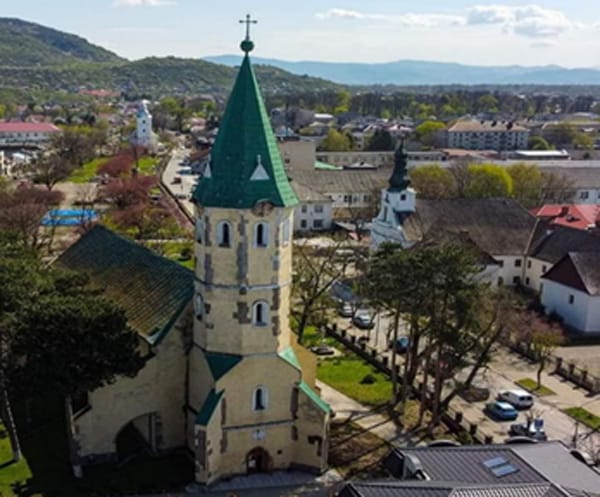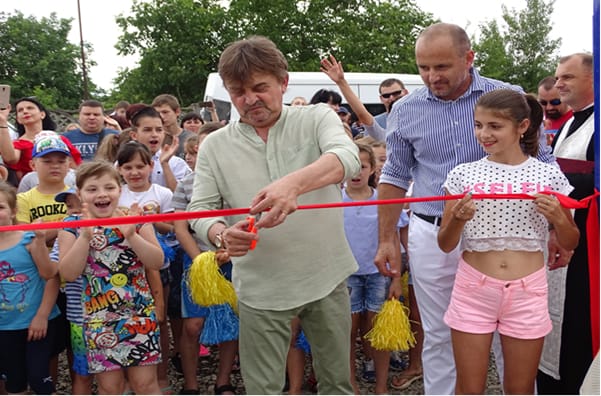This website uses cookies so that we can provide you with the best user experience possible. Cookie information is stored in your browser and performs functions such as recognising you when you return to our website and helping our team to understand which sections of the website you find most interesting and useful.
Vynohradiv Territorial Community

The Vynohradiv Urban Territorial Community is part of the Berehovo District of the Zakarpattia Region. The border with Hungary and Romania is no more than 15-20 km away from it.
The total area of the territory: 248.7 km²
Population: 64,724 residents
Children (under the age of 15): about 20,000 residents
Pensioners: about 11,170 residents
The Community includes fourteen settlements with its administrative centre being in the town of Vynohradiv.
History
The Vynohradiv Community was formed in 2020.
The town of Vynohradiv, Sevlush (the name of the town until 1946) is known for the fact that in 1262 the Hungarian king István V granted the town the status of a royal one.
In general, history can be felt in Vynohradiv everywhere, but most strongly in its religious buildings: the Church of the Ascension (14th century), which was the centre of the public life of the townspeople, a witness of stormy historical events; the reformation church (15th century) and the Franciscan monastery (16th century), which now houses an ancient organ.


During the Austro-Hungarian period, the Sevlush Synagogue was built in 1874. It is currently being restored and the building will have its authentic appearance.
The oldest monument of palace architecture is the palace of Baron Pereni, the ancestral seat of a local feudal lord. The park (about eight hectares) around the palace is called “little Versailles” and was laid about 200 years ago.

Vynohradiv image is largely shaped by its natural wonder – Black Mountain, at the foot of which the town is located. This is a botanical reserve of national importance. On Black Mountain, there is a cave that extends deep into the mountain and ends with a small reservoir, which was called the Sea Eye by the local population and has been associated with numerous legends.
The Kankiv Castle dates back to the 13th century, although it was first mentioned in an anonymous Hungarian chronicle in 903. Between 1505 and 1557, a Franciscan monastery and a church stood near the castle. The ruins of the Gothic church are still visible today. Today, only the ruins of the castle remain, which at one time was an important fortification.


Economy and Welfare
Proximity to the border with Hungary, Romania, Slovakia and Poland helps to establish relations with foreign partners. Foreign economic activities are carried out by thirty-six enterprises from twenty-nine countries of the world.
Fourteen industrial enterprises develop exponentially producing food products, textiles, footwear, chemical products, and electronic equipment.


According to climatic conditions, this is the warmest area of the region, which contributes to the cultivation of agricultural crops. Greenhouse facilities are developed.

Tourism is developing in the Community. Numerous cultural and historical landmarks, four active tourist routes, a tasting room, eighteen hotels, a motel, two sanatoriums, two tourist and entertainment complexes, private estates are available to tourists.

The Carpathian Buffalo farm actively works in the Community; there they restore the population of Carpathian buffaloes and produce dairy products.

One of the massifs of the Carpathian Biosphere Reserve is located in the territory of the Community, which provides opportunities for the development of ecotourism and recreation in a natural environment.

Much attention is paid to music and art education; both public and private schools of art, dance and music work in the Community. The Community has an amateur folk orchestra of folk instruments and a vocal trio, who perform concerts and hold charity events in support of those affected by the war in the East of the country. The orchestra recently returned from a tour to Austria at the initiative of the Piano Dreams piano school and with the support of the Wolfsberg community.

Community and War
The demographic situation in the Community, and in Ukraine as a whole, has been significantly affected by the full-scale invasion of russia, which, on the one hand, led to the migration of local residents abroad, and, on the other hand, to their replacement by internally displaced persons.
One of the first challenges arising in wartime was the receipt of internally displaced persons. On 24 February 2022, a centre was created for immediate response to various problems.

A large flow of internally displaced persons has passed through the Community – more than 7,000 people. Today, about 1,500-2,000 of them are staying in the Community. The building of the former dormitory has been overhauled and 100 to 120 internally displaced persons have been accommodated there.
One food industry enterprise has been relocated to Vynohradiv, and five individual entrepreneurs have moved from the eastern regions of the country.
The Community has received numerous shipments of humanitarian aid from European countries, which have been sent to the war zone and de-occupied territories.


The entire Vynohradiv Community actively helps the military.

Local industrial enterprises have preserved their production facilities and employees. Part of the enterprises took an important place in the national economy and in meeting the basic needs of the population in wartime.
The Armed Forces of Ukraine and the territorial defence units are supplied with uniforms, winter windproof, camouflage kits, summer field uniforms, etc.
The Community is well-known in the volunteer milieu for its active organizations, including the “Movement to Support the Zakarpattia Military. Vynohradiv Office”.

The hospitable land of the Vynohradiv Community is glad to receive and help citizens who have been forcibly resettled to realize themselves. The family of Oleh Omelchenko, a Kharkiv artist and a teacher at the Academy of Arts, moved to the communication community because of the full-scale invasion. Oleh organized a sketching and quick drawing studio in the exhibition hall, which has been working for two years in a row, holds lectures, participates in artistic meetings, created a mural in the territory of one enterprise and a series of portraits of cultural figures of the town.

People of the Community
The Community is famous for its talented, sincere, kind, hard-working people who create the future of Ukraine today, honour its history and preserve the spiritual traditions of the Ukrainian people. The residents of the Community have been defending the state sovereignty and territorial integrity of the country since 2014.
The head of the Vynohradiv Territorial Community is Stepan Bochkai, who has been serving the Community for more than 20 years.

Since the creation of the Vynohradiv Community and under the leadership of Stepan Bochkai, the local self-government has been actively promoting a whole range of development projects. The most important of them include:
- a) creation of a transport hub based on a network of railways and highways. The island-type community station is the only one in the Zakarpattia Region used by standard and European gauge trains. The European track runs to Hungary and Slovakia, cargoes are transited from Romania;
- b) development of the tourist and recreational area (conservation and further restoration of the Kankiv Castle, development of roadside infrastructure (recreation places, parking lots, camping sites, etc.);
- c) reconstruction of the Plastmasovyk stadium;
- d) reconstruction of water supply and sewage networks in the town of Vynohradiv.
Considering the limitations and difficulties in attracting funds from the state and local budgets due to martial law, the search for alternative sources of funding and participation in international grant projects is very relevant.
The reconstruction of Myru Street and Myru Square in the town of Vynohradiv is about to be completed; it is supposed to improve the mobility of border residents, within the framework of the Hungary-Slovakia-Romania-Ukraine TC Program 2014-2020 of the European Neighbourhood Instrument.


Development Strategy
The development strategy project until 2027 is being drafted in the Community with the support of the USAID HOVERLA Project.

The Community Development Strategy plans to:
– create a business support centre, a platform for the presentation and sale of local craft products;
– build a by-pass road in the town of Vynohradiv, modern sports grounds in the villages of the Community and bank fortification structures, which will make it possible to stop the erosion processes of the left bank of the Borzhava River and prevent the dam from destruction;
– establish a system of urban public transport and improve the operation of the transport network between the villages of the Community;
– carry out the reconstruction of the existing network in the town and construction of water supply networks in the villages;
– create three reception points for secondary raw materials in the settlements of the Community;
– buy three school buses for transporting students to educational institutions;
– improve the material and technical resources of culture centres, for uninterrupted work in wartime: purchase twenty-three electric generators and renew office equipment;
– establish a connection between the cultural milieu of the Community – music and art institutions of Europe, carry out the restoration of architectural landmarks with their integration into public space to ensure the inclusiveness of the sites;
– carry out major repairs of the perinatal department of the hospital and purchase modern medical equipment;
– develop and ensure the operation of the Ukraine Travel tourist web portal in several languages;
– create virtual tours and publications in the Google Maps server.
Due to the geographical location and natural factors of the Community, priority sectors for investment and development include processing (light, food) industry, agriculture, farming (horticulture, viticulture, berry and nut crops), tourism and recreation, as well as alternative energy.

